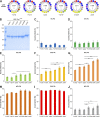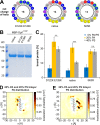The molecular recognition of phosphatidic acid by an amphipathic helix in Opi1
- PMID: 29941475
- PMCID: PMC6122994
- DOI: 10.1083/jcb.201802027
The molecular recognition of phosphatidic acid by an amphipathic helix in Opi1
Abstract
A key event in cellular physiology is the decision between membrane biogenesis and fat storage. Phosphatidic acid (PA) is an important intermediate at the branch point of these pathways and is continuously monitored by the transcriptional repressor Opi1 to orchestrate lipid metabolism. In this study, we report on the mechanism of membrane recognition by Opi1 and identify an amphipathic helix (AH) for selective binding of PA over phosphatidylserine (PS). The insertion of the AH into the membrane core renders Opi1 sensitive to the lipid acyl chain composition and provides a means to adjust membrane biogenesis. By rational design of the AH, we tune the membrane-binding properties of Opi1 and control its responsiveness in vivo. Using extensive molecular dynamics simulations, we identify two PA-selective three-finger grips that tightly bind the PA phosphate headgroup while interacting less intimately with PS. This work establishes lipid headgroup selectivity as a new feature in the family of AH-containing membrane property sensors.
© 2018 Hofbauer et al.
Figures






References
-
- Abraham M.J., Murtola T., Schulz R., Páll S., Smith J.C., Hess B., and Lindah E.. 2015. Gromacs: High performance molecular simulations through multi-level parallelism from laptops to supercomputers. SoftwareX. 1–2:19–25. 10.1016/j.softx.2015.06.001 - DOI
Publication types
MeSH terms
Substances
LinkOut - more resources
Full Text Sources
Other Literature Sources

